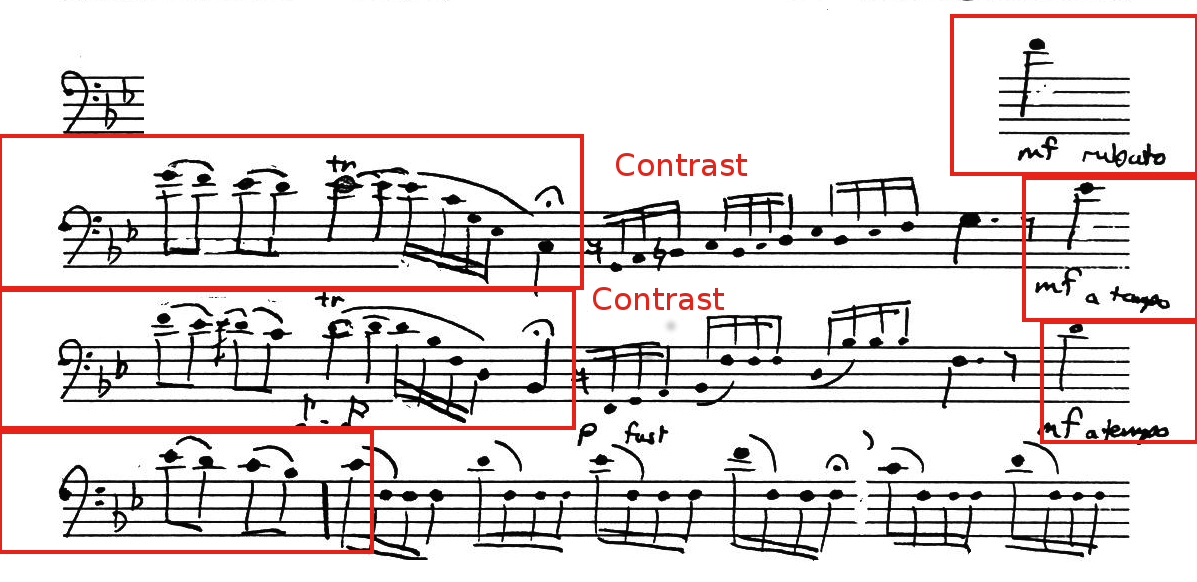<music: Vincent Igusa, bassoon, and Catherine Renggli, piano. Towson University Recital Hall, 20 June 2017.>
1. Well, wonderful. This will be our last video on writing a cadenza for the first movement of Mozart’s Bassoon Concerto. In video 6, I presented three cadenzas and we considered how best to match the style of cadenzas in Mozart’s period. Video 7 introduced the idea of having a harmonic plan for the cadenza and we have seen some possible conclusions to the cadenza. Now in this video, number 8 in the series, we need to consider the opening and the middle sections of the cadenza.
2. I suggest that you begin writing the opening and middle section of your cadenza by collecting some melodic fragments from the bassoon or orchestral parts. For instance, here are some ideas to consider:
3. I have placed in red boxes possible ideas for the cadenza. Look at how rich these eight measures are! There are more ideas here than needed for an entire cadenza. You could choose other ideas throughout the movement as well. With so many ideas and possibilities, there are almost unlimited ways to construct a cadenza for this movement.

4. Usually Mozart’s opening statements in his cadenza’s do not duplicate the opening statement in the solo instrument. Mozart, however, provides two Bb3s, which appear to reference the opening statement in the solo bassoon part. Starting either by quoting the opening statement or another section would be appropriate.
5. The opening statement needs to start well from the cadential 6/4 chord, in this case a Bb major chord. So, the safe thing to do is to start by outlining the chord in your melody.
6. In this figure you see the violin parts at the top and a new opening composed for this video. Notice that I start with the Cadential 6/4 chord, using F, Bb, and D and make use of the rhythm and contour of the first fragment in the violin part.

7. See how that idea is elaborated a few times. Here I decided to move the upper note in each by a step to create an appealing melody with direction. After the third repeat, it is time to break off with something else, so I decided to imitate the last melodic fragment in the violin example for that passage. I end with a V7 harmony in mind, setting up a more virtuosic section in the tonic key.
8. Here is how Vincent’s opening statement borrowed from measure 32 in the tutti section. He then borrows from the bassoon part in measure 51 in the last measure of the example.

9. So, my framework for the middle section is on the screen. You can see the opening section we created, the blank space for the middle section and then a diminished 7th chord leading to the conclusion. I really like the idea given in Mozart’s first cadenza where he approaches the pedal tone with a diminished 7th chord, so let’s end my middle section with that chord.

10. Sequences and repetition are important features of middle sections in Classical cadenzas. I have decided to start with the trill section in the Bassoon Solo at measure 51, but I will vary it just a bit. Then I will repeat it down a step, adjusting the notes to fit a V7 chord. Another repetition, higher in the V7 chord continues it, and then I return back to the tonic, I. The adventure wasn’t too far I have returned safely back to “home.”

11. Now we need something else. I have already used that idea enough. Let’s use the last two ideas in the string part, but instead of the arpeggios going downward, I need them to ascend. Since I end on a D in the first statement it is quite nice to start on a D in the second statement.

12. Now I need a little bit of music to take me from the D4 and get me to E4 in my diminished chord. Just repeating the last statement in the violin section in upward steps works great for this. Now let’s hear how the whole thing sounds.

13. In Vincent’s middle section, here is the sequential pattern he uses. It is repeated twice and then breaks off after the third time.

14. The sequential pattern in my cadenza is unusual due to the insertion of contrasting materials.

15. On 2reed.net you will find copies of the cadenzas by Vincent, some of my other students, and me. All of these are provided with the kind permission of the authors. I hope that these give you further ideas for your cadenzas.
16. I hope that these discussions of how to write a cadenza for the Mozart Bassoon Concerto have been helpful for you. Be inspired! Take the challenge and write your own cadenza. Perhaps in the future I will be able to hear what you have written. I look forward to it!
<music: Vincent Igusa, bassoon, and Catherine Renggli, piano. Towson University Recital Hall, 20 June 2017.>
